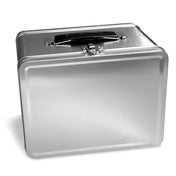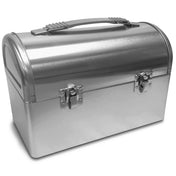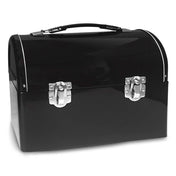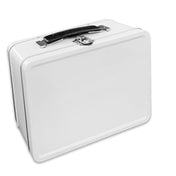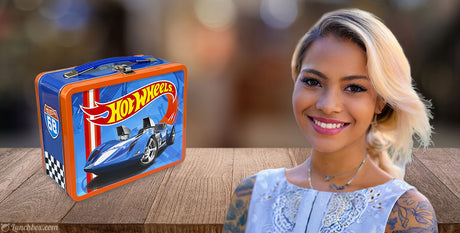Before the Age of Steel
According to The Whole Pop Magazine, before the lunch box was the lunch pail (and before the lunch pail there were oiled goatskins, but let's not go THAT far back). The lunch pail wasn't really a pail; it was a latching, heavy-duty metal thing made from a toolbox-grade metal that would protect the working man's noontime meal from anything less powerful than a small bomb.
At the time, a lunch pail wasn't chic--on the contrary, it was a sign you were far enough down the pay scale that you didn't have time or money for a decent hot noontime meal. Still, children in the 1880s created their own school "lunch pails" out of the colorful tin boxes that once housed biscuits, cookies and tobacco.
From there, it was a small step to a box specifically made for that purpose, and in 1902 the first true kids' lunch box came out. No, it didn't feature turn-of-the-century pop culture idols like P. T. Barnum, Buffalo Bill or Sousa's Band--it was shaped like a picnic basket with pictures of playing children lithographed on its side.
Beyond the Pail
A Mickey Mouse lunch box in 1935 was a forerunner to what was to come, but it wasn't until 1950 that the medium entered its prime. A company called Aladdin emerged from Nashville with the first in an odd postwar marriage of cold sandwiches and hot popular culture.
It was a move of desperation. The postwar market had created a demand for all kinds of consumer goods which Aladdin had ridden for a few good years, but metal lunch boxes are durable and once you bought one, there was no reason to buy another for a decade or two. Staring at charts of slumping sales, Aladdin execs started throwing around ideas:
"We've got these plain boxes--why don't we jazz them up with decals?"
"Kids seem to like cowboys and Indians, and TV stations are showing a lot of old western movies to fill time."
"Not just cowboys and Indians, how about using a TV cowboy? Maybe Hopalong Cassidy?" Aladdin, taking a cue from the auto market, had stumbled into the idea of planned obsolescence in which people would replace perfectly good products for the sake of fleeting style. The company hired a top industrial designer who sketched out a prototype of the cowboy star, which they slapped onto the side of a red lunch box. On the strength of that, they convinced a big department store chain to make an advance order of 50,000.
To everyone's surprise, the "Hoppy" lunch box jumped off the shelves. Fueled by a craze for anything seen on TV, Aladdin sold 600,000 at $2.39 each in their first year. (They had even greater success in 1952 with another decal of another hot show: Tom Corbin, Space Cadet.)
Happy Trails
Meanwhile, back at the ranch, another cowboy star was jealous. Roy Rogers wanted his own box, but Aladdin had turned him down with "one cowboy is enough."
So Roy saddled up Trigger and rode north to American Thermos in Connecticut, which also had been feeling slumping sales from its lunch box / thermos sets, and especially now with Aladdin's success. AT decided to do Aladdin one better by using bright, full-color lithography on all sides of the box instead of a decal on one face. They sold 2 1/2 million Roy Rogers & Dale Evans boxes in 1953, increasing their total sales 20% in one year.
Aladdin retooled and adapted full-lunch box lithography for their 1954 line. So did some newcomers, ADCO Liberty and Universal, as well as another old-style lunch pail manufacturer, Ohio Art (which a few years later, flush with lunch box profits, diversified into making toys including Etch-A-Sketch). The box wars had begun, as manufacturers scrambled to be the first to tie up rights to the hot new TV shows.
In 1962, Aladdin added another trademark feature: They stamped the designs into the metal, giving a bas relief, 3-D effect.
Domes
Square boxes were great for their TV screen-like dimensions, but much of the highest artistry went onto the "domes" with rounded tips which aped the shape of the original workingman's lunch pail. Ironically, though now much sought-after for their designs, they were begun as a cost-cutting measure.
You see, the cost of buying rights to licensed characters and TV shows, some of which would be canceled before the box had a chance to sell, was becoming astronomical. Aladdin decided to create some generic-subject boxes and decided the new shape would be a novelty selling point. Its artists rose to the challenge, given a bigger canvas and freed of the tyranny of having to please temperamental producers and stars (Rex Harrison, for example, bounced the art for the Dr. Dolittle box six times before okaying it).
Aladdin's first dome, "Buccaneer" in 1957, capitalized on a pirate craze that had been spurred on by Peter Pan and other movies of the era. It was a huge success. From there, domes featured other whimsical patterns, some of which--like the VW Bus and the Disney Schoolbus, which at 9 million units was the biggest seller of all time--used the shape of the boxes to brilliant effect.
Vinyls
The vinyl lunchbox was a trend that was as short-lived. Described by an industry insider as "a piece of shower curtain plastic, heat-sealed over cardboard," the vinyls were usually colored pink and aimed at girls.
The Barbie line did well, as did a Beatles box and a generic called "Bobbie Soxer," but their bad designs and lack of durability sunk vinyls pretty quickly.
Relatively few have survived to our time.
Decline & Fall
Lunchboxes had had a good run, selling about 120 million between 1950 and 1970, but the box boom couldn't last. ADCO stopped making in 1956; Universal in 1963; Ohio Arts in 1985 What happened?
Blame it on kids, who came up with other status symbols to beg their parents for. Blame it on manufactures who in 1972 began switching to plastic molded--inferior in every aesthetic way to metal-- to cut manufacturing costs. And blame it on crusading mothers and pandering legislators who began passing legislation to ban metal as dangerous assault weapons. The last metal lunch box of the Steel Age, fittingly depicted that hailed conking hero, Rambo. That was in 1987.
Even with plastics, Aladdin announced that it was giving up the lunch box business completely in 1998, leaving only Thermos standing tall. And yet....
Lunchbox Redux
Despite the "death" of quality, they're slowly coming back. Thermos slipped a few metal boxes into their lunch lines last season, and if you take a look around department stores and gift shops, you might just find some neo-nostalgia metal boxes by little-known names like the candy-filled, made-in-China boxes of American Specialty Confections: Some are reissues of classic designs of the past, others are new but with a retro look.
The other thing is that some of the new aren't so bad. Although too many are still just a standardized plastic box with a sticker slapped on it, some of the Thermos fabric soft-sides like Minnie Mouse are colorful and fun. Or their whimsically-shaped Barbie Dream house. While the metal boxes still seem aimed squarely at aging Baby Boomers, could it be that the lunchbox as a form of popular art will rise again among elementary school trendsetters?

